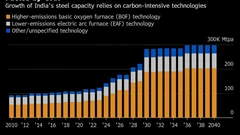World Has Hottest Summer Ever as Climate Extremes Increase
(Bloomberg) -- This summer was the hottest ever in the Northern Hemisphere, putting the Earth on track for another record-breaking year.
The European Union’s Copernicus Climate Change Service reported that for June to August, global temperatures were 0.69C above historical averages, beating the previous high set last year. The record for the world’s highest average temperature was broken on a number of days over the summer.

Climate change is increasing the frequency and intensity of heat waves, triggering extreme weather events from droughts and wildfires to violent storms and flooding. Over the past 12 months, the global average temperature was 1.64C higher than pre-industrial levels, above the 1.5C threshold that policymakers and scientists say threatens life on the planet.

In Europe, the heat over the June to August period was 1.54°C above the 1991-2020 average, according to Copernicus. The most extreme conditions were recorded in the Mediterranean region and Eastern Europe, while the UK, Iceland, parts of Ireland, the west coast of Portugal and southern Norway were cooler than the norm.
Across the world, soaring temperatures are testing the limits of the human body, posing threats and even causing deaths at outdoor activities such as concerts, sports events, and religious gatherings. More than 1,300 people died during the Hajj pilgrimage in Saudi Arabia in June after temperatures reached 52C (126F). There were heat-related fatalities in nations including the US, Thailand, India, and Mexico this year.
China’s weather authority said the nation had its hottest summer since records began in 1961, with heat scorching crops from rice to corn. US cities also experienced historically high temperatures, and New York canceled commuter trains as rails overheated. And parts of the Southern Hemisphere just had a very mild winter, with Australia experiencing the hottest August since data started in 1910 and looking forward to a warmer-than-average spring.
This summer the effects of a strong El Niño weather pattern, which causes warming in the Pacific Ocean, started giving way to the La Niña phenomenon. This shift usually means less extreme heat, but it can also bring droughts in some areas and produces flooding and hurricanes elsewhere.
Listen on Zero: Healthy? Doctors Say Extreme Heat Could Still Threaten Your Life

(Updates with more global context in the 5th and 6th paragraphs.)
©2024 Bloomberg L.P.
KEEPING THE ENERGY INDUSTRY CONNECTED
Subscribe to our newsletter and get the best of Energy Connects directly to your inbox each week.
By subscribing, you agree to the processing of your personal data by dmg events as described in the Privacy Policy.
More renewables news

WEC Energy Offered $2.5 Billion US Loan for Renewable Projects

With Trump Looming, Biden’s Green Bank Moves to Close Billions in Deals

GE Vernova Expects More Trouble for Struggling Offshore Wind Industry

Climate Tech Funds See Cash Pile Rise to $86 Billion as Investing Slows

GE Vernova to Power City-Sized Data Centers With Gas as AI Demand Soars

Longi Delays Solar Module Plant in China as Sector Struggles

Australia Picks BP, Neoen Projects in Biggest Renewables Tender

SSE Plans £22 Billion Investment to Bolster Scotland’s Grid

A Booming and Coal-Heavy Steel Sector Risks India’s Green Goals
















